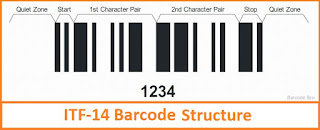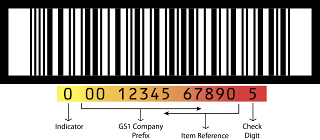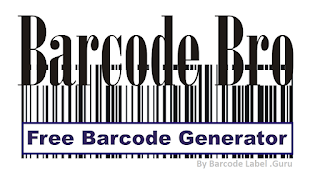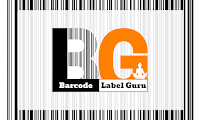What is an ITF-14 barcode?
ITF-14 is the GS1 System’s only use of Interleaved 2 of 5 and it is only used to encode the GTIN as a 14 digit number. It is commonly used on shipping boxes and containers. The minimum recommended bar height for an ITF-14 Barcode is 32mm (1.25″) when used in General Distribution Scanning environments (automated scanning).
What is a GTIN-14 bar code?
ITF-14 is a 14-digit bar code that uses the “Interleaved 2 of 5” symbology (I2of5, or ITF). The GTIN-14 data can also be conveyed in other GS1 barcode data carriers, such as a GS1-128 barcode. ITF-14 bar code symbols include bearer bars, which are surrounding bars that protect the bar code image.
How do I print ITF-14 bar code symbols on a corrugated carton?
If the ITF-14 is printed directly on a corrugated carton it must be surrounded by bearer bars. For ITF-14 bar code symbols printed on a label, only horizontal bearer bars along the top and bottom are necessary. The following illustration displays example images and the minimum sizing for each scenario.
What are GS1-128 & ITF-14 barcodes?
You will find relevant application standards and guidelines listed below: GS1-128 and ITF-14 are highly versatile 1D barcodes that enable items to be tracked through global supply chains. The GS1-128 barcode can carry any of the GS1 ID keys, plus information like serial numbers, expiration dates and more.
ITF14 barcode is the GS1 implementation of an Interleaved 2 of 5 bar code to encode a Global Trade Item Number. It is continuous, self-checking, bidirectionally decodable and it will always encode 14 digits. ITF-14 is used on packaging levels of a product in general.
ITF-14 is the GS1 implementation of an Interleaved 2 of 5 bar code to encode a Global Trade Item Number. It is continuous, self-checking, bidirectionally decodable and it will always encode 14 digits. ITF-14 is used on packaging levels of a product in general.
ITF-14 Structure
The structure of ITF-14 is as below:
ITF-14 Barcode Size Setting
X module: the theoretical widths of the bars (light or dark) are:
Narrow bar = 1.016 MMT (0.04 INH)
Wide bar = 2.540 MMT (0.10 INH)
N dimension (wide/narrow bar ratio): 2.0 to 3.0 inclusive. The recommended width of the wide bars (dark bars) is 2.5 times the width of the narrow bars (dark bars).
Quiet zone: Qmin= 10X. ITF-14 has target widths of 10.2 millimeters (0.40 inch).
Bearer Bars: For printing methods requiring printing plates, the nominal Bearer Bar has a constant thickness of 4.8 millimeters (0.19 inch) and must completely surround the symbol, including its Quiet Zones, and butt directly against the top and bottom of the bars (dark bars) of the symbol.
However, for printing methods that do not require printing plates, it is not mandatory to print the vertical sections of the bearer bar. A minimum space of 1 millimeter (0.04 inch) between the bottom line of the Bearer Bar and the top of the human readable characters is required. So the bearer bar should be a minimum of twice the width of a narrow bar.
Barcode height: For ITF-14 Symbols, the height of the bars (dark bars) in the target size symbol is 32 millimeters (1.25 inches).
Logistic shelf and master cartons should be identified with a GTIN-14 identifier. In most environments, these cartons are not read by point-of-sale scanners and do not carry a UPC barcode symbol. An ITF-14 barcode encodes the GTIN-14 information.
Human Readable Interpretation of ITF-14: Human Readable Interpretation may be printed anywhere in the area surrounding the symbol as long as the Quiet Zones are not encroached upon. As for specific ITF-14 symbol size setting, two factors should be considered: X dimension, N dimension and barcode width.
Indicator – This denotes the level of packaging for a particular carton. This one-digit prefix can range from 0 to 8.
GS1 Company Prefix – Vendors must obtain a GS1 Company Prefix directly from GS1 to uniquely identify their company. Depending on the number of items a company needs to identify, a GS1 Company Prefix may be 7 to 10 digits in length.
Item Reference– References the same product number used for the item level GTIN (GTIN-8, GTIN-12, GTIN-13) when a carton is made up of the same item. For cartons that contain an assortment of items a new product number is assigned.
Check Digit – The last digit of GTIN-14 is a calculated check digit. Using a MOD10 check digit algorithm, the calculated check digit prevents substitution errors.
ITF-14 BARCODE SYMBOL
The ITF-14 barcode is the most common data carrier used for the GTIN-14 data structure in retail organizations. ITF-14 is a 14 digit bar code that uses the “Interleaved 2 of 5” symbology (I2of5, or ITF). The GTIN-14 data can also be conveyed in other GS1 barcode data carriers, such as a GS1-128 barcode. ITF-14 barcode symbols include bearer bars, which are surrounding bars which protect the barcode image. If the ITF-14 is printed directly on a corrugated carton it must be surrounded by bearer bars. For ITF-14 bar code symbols printed on a label, only horizontal bearer bars along the top and bottom are necessary. The following illustration displays example images and the minimum sizing for each scenario.
ITF-14, also known as UPC Shipping Container Symbol ITF-14, ITF14, is the GS1 implementation of an Interleaved 2 of 5 barcode to encode a Global Trade Item Number. ITF-14 symbols are generally used on packaging levels of a product, such as a case box of 24 cans of soup. The ITF-14 will always encode 14 digits.
What is the benefit of ITF-14?
The ITF-14 is a durable barcode that is less sensitive to poor print quality. It is therefore suitable when a barcode needs to be printed directly on corrugated board.
The basic characteristics of ITF-14 barcode are:
Encodable character set: numeric 0 to 9 (ASCII characters 48 - 57 inclusive, in accordance with ISO/IEC 646)
Code type: continuous
Character self-checking: yes
Data string length encodable: fixed length at 14 digits
Barcode check digit: One check digit is required
The purpose of a bearer bar is to equalise the pressure exerted by the printing plate over the entire surface of the symbol and to enhance reading reliability by helping to reduce the probability of misreads or short scans that may occur when a skewed scanning beam enters or exits the barcode through its top or bottom edge.
The ITF-14 bearer bar is mandatory unless it is not technically feasible to apply it (in which case reading reliability will be reduced).
For printing methods that do not require printing plates, the bearer bar SHALL be a minimum of twice the width of a narrow bar (dark bar) and need only appear at the top and bottom of the symbol, butting directly against the top and bottom of the symbol bars (dark bars). The bearer bar may extend above and below the Quiet Zones.
What is the data length of ITF-14 barcode?
With ITF-14 barcodes, the data string, including the check digit, will always be a 14-digit number.
ITF-14 Start/stop patterns
ITF-14 includes one start pattern, and one stop pattern.
The start pattern shall consist of four narrow elements in the sequence "bar - space - bar - space". The stop pattern shall consist of a "wide bar - narrow space - narrow bar" sequence.
The start pattern shall be positioned at the normal left end of the data symbol characters adjacent to the first bar of the most significant digit. The stop pattern shall be positioned at the normal right end of the data symbol characters adjacent to the final space of the least significant digit.
There is no assigned human readable interpretation of the start and stop patterns and the start/stop will not be displayed in the ITF-14 barcode text.
How to calculate ITF-14 barcode check digit?
For applications requiring enhanced data security, ITF-14 should include one checksum digit as a symbol check character.
When a check digit included, the following check character algorithm shall be used:
Starting with the digit on the right of the number (excluding the check character), sum all the alternate digit values, reading from right to left;
Multiply the result of step 1) by 3;
Sum all the remaining digit values;
Add the result of step 2) to the result of step 3);
The check character is the smallest number, which, when added to the result of step 4), produces a multiple of 10.
ITF-14 barcode dimension size
ITF-14 symbols SHALL use the following nominal dimensions:
Width of narrow element (X): the X-dimension of ITF-14 symbols is defined by the application specification based on the needs of the application. Refer to section 5.12.2.6 for specifications by application area.
The wide/narrow ratio (N): the range is 2.25:1 to 3.0:1. Refer to section 5.12.2.6 for specifications by application area.
The Quiet Zones to the right and left of the symbol are compulsory. The minimum width of each Quiet Zone is 10X.
A minimum space of 1.02 millimetre (0.040 inch) between the bottom line of the bearer bar and the top of the human readable characters is required.
As an example, for an ITF-14 barcode symbol that has seven character pairs, a target wide-to-narrow ratio of 2.5:1, a target X width of 1.016 millimetres (0.0400 inch) and Quiet Zone widths of 10.16 millimetres (0.400 inch) the total symbol width is 142.75 millimetres (5.620 inches).
ITF-14 minimum X-dimension
ITF-14 barcode minimum X-dimension is 0.495mm. Its recommended X-dimension is also 0.495mm.
ITF-14 maximum X-dimension
ITF-14 barcode maximum X-dimension is 1.016mm.
ITF-14 minimum height
ITF-14 barcode minimum height is 31.75mm. Its recommended barcode height is also 31.75mm.
Note: For ITF-14 the height is measured from the bottom to the top of the bars, excluding the bearer bars.
ITF-14 maximum height
ITF-14 barcode maximum height is 31.75mm.
Quiet zone minimum size
The minimum width of the Quiet Zone to the left and right of the ITF-14 barcode is 10X.
The ITF-14 barcode is used to create the Shipping Container Symbol. This code is used to mark cartons and palettes that are including goods with an EAN-13 code. One digit is added in front of the EAN-13 code to mark the packing variant.
The first digit is the "Logistic Variant", also named as "Packaging indicator".
The next 12 digits are representing the product number. General this the EAN-13 number without the check digit.
The last digit is the check digit. ActiveBarcode calculates this digit automatically.
The name ITF-14 is a composition of the barcode symbol used: "Interleaved 2 of 5" (Code 25 Interleaved) and the 14 digits: the length of the container symbol. ITF is an abbreviation of "Interleaved Two of Five"
The ITF-14 barcode itself can optionally have a thick solid bar all around the main code. They are called "bearer-bars". ActiveBarcode does currently no support these additional bars. They are not required for barcode recognition.
Generate Free ITF-14 Barcode From





